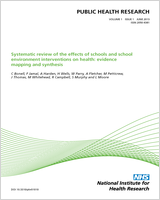Included under terms of UK Non-commercial Government License.
NCBI Bookshelf. A service of the National Library of Medicine, National Institutes of Health.
Bonell C, Dickson K, Hinds K, et al. The effects of Positive Youth Development interventions on substance use, violence and inequalities: systematic review of theories of change, processes and outcomes. Southampton (UK): NIHR Journals Library; 2016 May. (Public Health Research, No. 4.5.)

The effects of Positive Youth Development interventions on substance use, violence and inequalities: systematic review of theories of change, processes and outcomes.
Show detailsTABLE 18
Application of theory synthesis to descriptions of Positive Youth Development interventions included in the process and outcome evaluations
| Area of theoretical literature from which characteristics derived | Developmental assets | Identity theories | Social Learning Theory | Socioecological theory | Expectation state theory | Critical theories | Social control theory | Multiple theories | ||||||||||
|---|---|---|---|---|---|---|---|---|---|---|---|---|---|---|---|---|---|---|
| Characteristic derived from theory | Is there a focus on thriving? | Is there reference to multiple, specific assets? | Is there a breadth of activities offered? | Can participants pursue some activities in greater depth? | Do participants learn skills from observing adults and/or peers? | Is there intervention to improve participants’ wider environments? | Do intervention activities explicitly address risk behaviours | Is there explicit reference to transforming society or challenging inequalities? | Is there reference to conformity, or contribution to society as it stands? | Are there leadership opportunities? | Do participants have some choice in which activities to pursue? | Do adult providers aim to develop affective rather than merely instrumental relationships with participants? | Do participants develop enduring (at least 1 year) relationships with adult providers? | Are positive behaviours rewarded or celebrated? | Is there explicit reference to hope or optimism in a young person’s potential? | Is there explicit reference to family like atmosphere or safe space? | Do participants carry out service in the community? | |
| Outcome evaluations | ||||||||||||||||||
| All Stars (Cross et al.,90 Gottfredson et al.91,92) | 0 | 0 | 1 | 0 | 0 | 0 | 1 | 0 | 0 | 0 | 1 | 0 | 0 | 0 | 0 | 0 | 1 | 4 |
| MAP (Gottfredson et al.93) | 0 | 0 | 1 | 0 | 0 | 0 | 1 | 0 | 1 | 0 | 1 | 0 | 0 | 0 | 0 | 0 | 0 | 4 |
| Cool Girls, Inc. (Kuperminc et al.95) | 1 | 1 | 1 | 0 | 1 | 0 | 1 | 0 | 0 | 0 | 1 | 0 | 1 | 0 | 1 | 0 | 0 | 7 |
| BBBS (Tierney98) | 0 | 0 | 0 | 0 | 0 | 0 | 1 | 0 | 1 | 0 | 1 | 1 | 1 | 0 | 1 | 0 | 1 | 7 |
| QOP (Rodriguez-Planas78) | 1 | 0 | 0 | 0 | 1 | 0 | 0 | 0 | 0 | 0 | 1 | 1 | 1 | 0 | 0 | 0 | 0 | 5 |
| Stay SMART (St Pierre and Kaltreider111) | 1 | 0 | 0 | 0 | 1 | 0 | 1 | 0 | 0 | 1 | 0 | 1 | 1 | 0 | 0 | 0 | 1 | 7 |
| PYDC (Tebes et al.79) | 1 | 0 | 1 | 0 | 0 | 0 | 1 | 0 | 0 | 1 | 0 | 0 | 0 | 0 | 0 | 0 | 1 | 5 |
| Process and outcome evaluations | ||||||||||||||||||
| YARP (Berg et al.86) | 1 | 0 | 0 | 1 | 1 | 1 | 1 | 1 | 0 | 1 | 1 | 0 | 0 | 0 | 1 | 0 | 1 | 10 |
| NGYCP (Millenky et al.107,108) | 1 | 0 | 1 | 0 | 0 | 1 | 1 | 0 | 0 | 1 | 1 | 1 | 1 | 0 | 0 | 0 | 1 | 7 |
| YPDP (Wiggins et al.46,112) | 1 | 1 | 1 | 1 | 1 | 1 | 1 | 0 | 0 | 0 | 1 | 1 | 0 | 0 | 0 | 0 | 1 | 10 |
0, not reported as present; 1, reported as present.
- Application of theory synthesis to descriptions of Positive Youth Development in...Application of theory synthesis to descriptions of Positive Youth Development interventions included in the process and outcome evaluations - The effects of Positive Youth Development interventions on substance use, violence and inequalities: systematic review of theories of change, processes and outcomes
Your browsing activity is empty.
Activity recording is turned off.
See more...